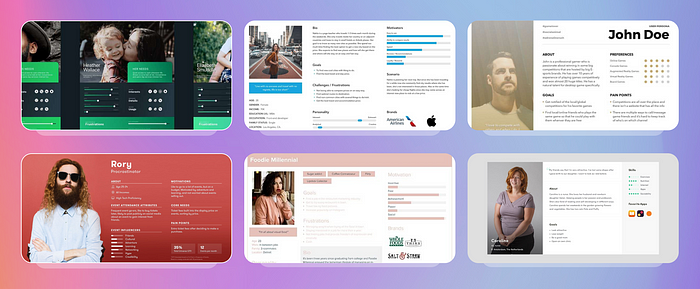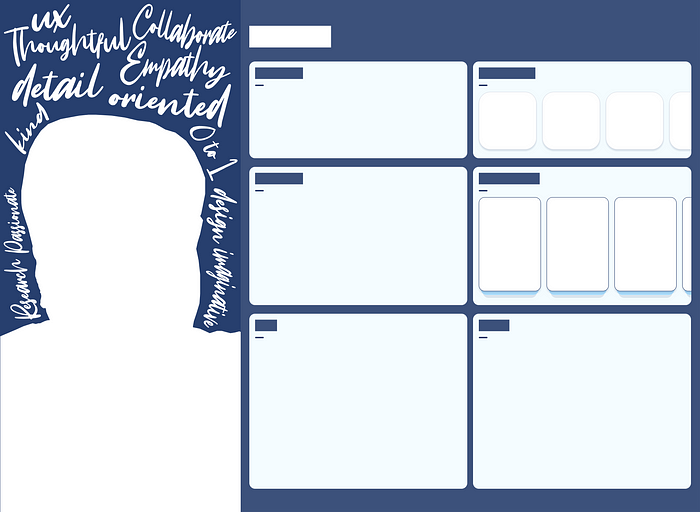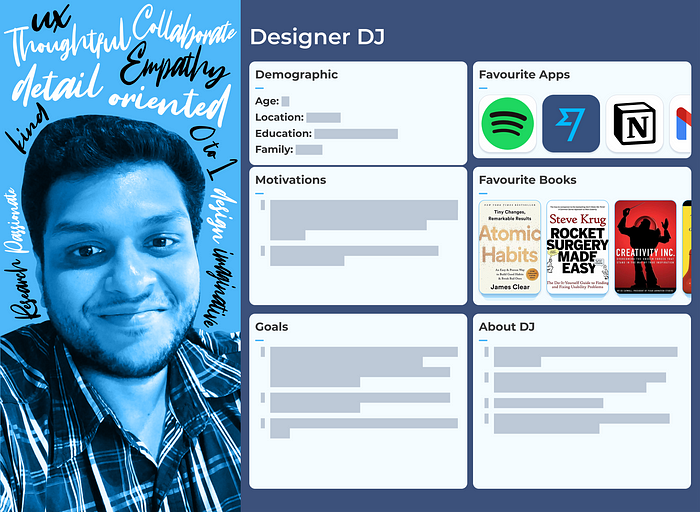

Constructing Your Persona in the Design Portfolio
source link: https://uxplanet.org/constructing-your-persona-in-a-design-portfolio-da325834cb64
Go to the source link to view the article. You can view the picture content, updated content and better typesetting reading experience. If the link is broken, please click the button below to view the snapshot at that time.


Samples of persona sheets
Constructing Your Persona in the Design Portfolio
Should you personify yourself in your design portfolio?
Designers have a love-hate relationship with portfolio personas. There is a good reason for that.
- Personas often serve as material used for business presentations.
- Designers/Researchers schedule calls with the end users to extract the needs and pain points of dozen users to put together these personas.
- But after all the process is followed, personas gather dust and don’t get used. Personas are meant to represent the user as an empty chair in all design decisions and meetings. That’s the real value of having a few key personas.
In a nutshell, persona mapping is a tool that helps designers and stakeholders to understand the user’s world and help make the right product decisions that align with the user’s needs, pain points, and goals. Taking that into perspective, as I was building my portfolio, I felt that I could modify the concept of personas to present myself to the recruiters. And given that my hiring manager is most probably a designer themselves, it would be a good idea to adjust a traditional persona sheet to my motivations, goals, and likings.
I understand that portraying myself (a single user) as a collective persona might be a bit controversial and not something that everyone would agree to. But in the spirit of iteration, I wanted to give it a try.
To fit my portfolio for a longer duration, I am going to modify the traditional requirements in persona mapping a lot. If you are building a persona sheet for your case study project then the values I discuss here can help you to draft yours.
Demographics
- Photo: This will enhance the visual appeal. It a good to keep it here and add an artistic twist to it.
- Name: This is needed as a reference point for the hiring manager.
- Age: Probably something I can remove because it is not a timeless piece of information and will need to keep changing every passing year.
- Work: I will have to remove this value because it seems like a repeat overall since the folks visiting my profile are searching for someone in the field of product design.
- Location: This value will inform the hiring manager and will impact my ability to look for a job in my current location or in a different currency. I might want to keep this information to myself till I get a face-to-face interview.
- Family: Will be keeping this in for logistical reasons.
- Education: Although education in the design field doesn’t hold a lot of importance workwise. It does hold importance during the visa process and countries abroad have a weightage for the level of education a person is immigrating with. For that reason, I have a preference to keep this information in my persona sheet.
Pain & Gains
To fit the portfolio landscape well, I will change pain points to goals.
Although both motivations and pain points are co-related, it is best to break them down into two blocks as these will be the source of wisdom to drive my personality and decision-making process. To fit the portfolio landscape well, I will change pain points to goals. Since goals directly inform my prospects and decision tree.
Scenarios
Instead of scenarios, I will swap this section for an “about myself” card in the sheet. The about section will describe my technical strengths, design personality, and love for design.
Preferences & Likings
One of the frequently asked questions in interviews is about the books that I have read recently and the apps that I like using. It seems that these are some of the variables that hiring managers like to learn a little bit about. I will be including these in my persona sheet to help the hiring manager learn about my preferences a little more.
Process Timelapse
I will be showing my visual design experience here in two slides to show the visual design process. The concept behind writing this post is to show my mindset and process for building this persona sheet. But I will be retracting most of the information so that others are motivated to add their information to the persona sheet.

Wireframe Structure

Final Format with Redacted Text
- Profile-pic: To make the pic stand out, I decided to use a full-height image and use the background to highlight some of my design approaches and qualities. For text morphing, I used .
- Favorite Apps: I undoubtedly adore and spend most of my time on apps like , (TransferWise formerly), , and some on Gmail and LinkedIn.
- Favorite Books: Although there can never be enough “fav” books that I can add to my collection, I am a life-long Pixar fan. Here are the 3–4 books that I decided to include:
- Atomic Habits: Because I am nothing without the systems I have built around me. In our weakest times, we fall back on our systems and not habits. (By
)- Rocket Surgery Made Easy: Because conducting usability doesn’t need to cost $5K-10K. Certainly, usability testing can dramatically improve products and is a how-to book for doing your own usability tests. (By
)- Creativity Inc: This is the best book ever written on innovation by a practitioner. Ed Catmull is a genius and he teaches us so much about building something that profoundly changed the animation business. The author takes us inside the Pixar ecosystem and shows how they build and refine excellence, in revelatory detail. (By Edwin Catmull)</div
Recommend
About Joyk
Aggregate valuable and interesting links.
Joyk means Joy of geeK